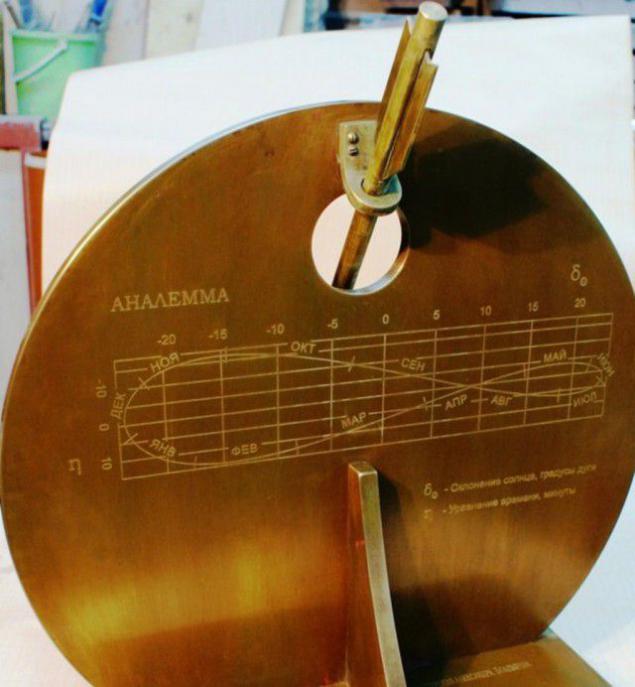1129
An asymmetrical eight

The mysterious eight is called analemma, which tracks the movement of the sun across the sky for a year. In general, the measurement of time is not always a measurement of progress, as we all think. Our modern calendars and watches are nothing but compromises: we are in a constant battle to synchronize these devices with the heavens.
Throughout human history, the daily flow of time has been determined by the movement of the sun. Noon occurs when the Sun reaches its highest point above the local horizon, crossing the northern or southern meridian. The problem is that the time of the passage of the Sun through the sky does not always correspond to the time of one revolution of the Earth around this star. So it doesn't match 24 hours. In October, the Sun reaches its highest point above the horizon 16 minutes earlier, in February 12 minutes later.
And why doesn’t the annoying universe want to remain constant?

And this discrepancy occurs due to two important factors: due to the elliptical orbit of the Earth and due to a certain angle at which the axis of our planet is inclined to the plane of the ecliptic. Of these two factors, the tilt of the planet's axis plays a primary role, and the ellipticality of the orbit is in the background. If the Earth’s orbit was a perfect circle, and its axis was always strictly perpendicular to the plane of the orbit, there would be no seasonal differences in time. But none of the known planets are in such ideal conditions.
As the Earth moves around the Sun in an ellipse, the speed of its orbit changes. The speed of movement around the Sun is maximum in January, and the slowest Earth moves in orbit in July. This animation compares ellipse motion and circular motion.
During the day, the earth A (which moves in a circle) passed a short distance and the observer on it looks at the Sun. Earth B (moving along the ellipse) traveled a slightly greater distance around the Sun. But because its orbital velocity is greater, it didn’t have time to completely rotate around it. This causes us to think that the sun in the sky is a little more east than it was yesterday at the same time.
Every day the difference will accumulate, and the sun will move more and more across the sky to the east. Further, moving along the ellipse, the Earth will reach its “summer” position in orbit and its movement will slow down. Then the sun in the sky will begin to shift slightly to the west.
As a result, it turns out that if the Earth's axis was not tilted, then instead of eight, the Sun would draw a straight line.
Now let's mentally tilt the Earth's axis. To us, sitting on the equator, it would look as if the entire sky with the Sun had moved around the Earth down (winter for the northern hemisphere) or up (summer for the northern hemisphere). For the Southern Hemisphere, it will be the opposite.

This photo was taken in Greece (in the northern hemisphere). The lowest part of the analemma was photographed in late December and the highest in June.

We owe the tilt of the earth’s axis to the seasons. In summer, the sun rises high in the sky and has time to warm up the air and the earth more strongly. In winter, the sun sets faster, the rays are reflected from the surface of the atmosphere, the temperature decreases.
If the Earth's orbit was circular, but the axis of rotation of our planet was still inclined to the plane of the orbit, then, under the specified conditions of observation, the Sun on the celestial sphere will move along a line to the north or south relative to the celestial equator in the range from 230.45 N to 230.45 S. lat. In this case, it will strictly repeat its trajectory when moving, both in one direction and in the other.
The change in the Earth’s orbital velocity is displayed by the unevenness of the Sun’s movement across the ecliptic in the sky (see Equation of Time). Therefore, the Sun at the selected moment of observation either does not reach or passes some special point, and the line unfolds in a figure similar to the eight.
The special point at which the Sun appears twice a year is located at the junction of the upper and lower part of the eight - analemma. This time falls on the middle of April and the very end of August of each year. The time of late arrival of the Sun at the "special point" on different days varies, but can reach 14 minutes 19 seconds, and the time of advance - 16 minutes 30 seconds. This means that the width of the analemma in the sky is 7.7 degrees.
The form of analemma is affected by the shift between some important calendar dates. Earth passes the point of perihelion on January 2. At this time, the velocity of the Sun along the ecliptic on the celestial sphere is maximum. The aphelion point is July 3, when the velocity of the Sun along the ecliptic is minimal.
On the other hand, the winter solstice is on December 22, and the summer solstice is on June 22 (see Solstice Points). In the northern hemisphere of the Earth these days there are moments when the Sun occupies its lowest and highest position above the horizon. The eleven-day shift between these two summer and two winter dates just determines the asymmetry of the eight - analemma.
Source: masterok.livejournal.com























